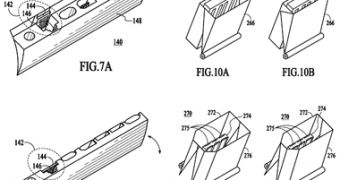Rumors of the Apple ultra-portable have died down since the iPhone came out, but a recent Apple patent is likely to stir them up again. The new Apple patent details how a notebook's I/O ports can better fit into a collapsible connection receptacle on the rear of the unit in order to conserve space.
In the recently published patent, Apple tackles the issue of designing thinner notebook computers, which at the moment are limited by the various pots that these devices usually have. The size of the notebook computer cannot be smaller than the largest of ports, which usually include USB, FireWire, RJ-11 and RJ-45.
Because some ports such as the RJ-45are relatively large, Apple proposes a "connection system" that includes a connection receptacle comprising a first component coupled to a chassis and a second component coupled to the first component.
"The connection system includes a connection receptacle that is implemented as two separate components. One of the components is fixed in that it is coupled to the chassis, and the other component is rotatable or coupled to a moving mechanism," the company explained. "The combination of the fixed and rotating components are adapted to receive a plug when the connection receptacle is in an open position, and the fixed and rotating components are collapsed into a compact configuration when the connection receptacle is in a closed position."
Using the design described by Apple, ports maintain their original form when in an open position, however, when the system swings to the closed or stowed position, the ports also swing into a stowed position becoming flush with the mobile device chassis.
The filing primarily describes an implementation where multiple ports are integrated into a single connection system, but does mention that each port could also be separated so that they can be open or closed independently of the other ports.
"Accordingly, this collapsing function enables a substantial reduction in the size of the connection system and thereby enables a substantial reduction in the form factor of a device implementing the connection system," Apple added. "For example, a notebook computer may have a highly tapered chassis shape."

 14 DAY TRIAL //
14 DAY TRIAL //